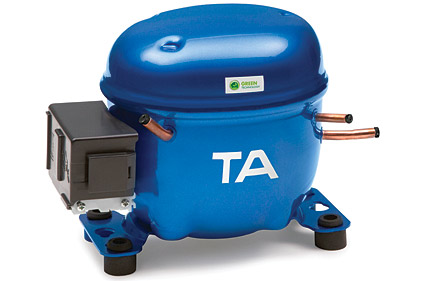
|
| The Tecumseh TA series compressor is optimized for hydrocarbon refrigerants. |
Whether or not HCs become major refrigerant players in the United States depends on who you talk to. Advocates point to extremely lower global warming potential, low cost, and a proven track record in Europe and Asia as making such refrigerants desirable. Others see the flammability issue, A3 safety rating, and current building and fire codes limiting use to smaller applications.
On the regulatory front, advocates say interest in HCs will jump start with pending action by the U.S. Environmental Protection Agency (EPA) giving Significant New Alternatives Policy (SNAP) approval for the use of HCs, which at the time this story was written in mid-November had not yet taken effect.
According to a white paper published by Emerson Climate Technologies and released in 2011, “The refrigeration industry is anticipating U.S. EPA SNAP approval of R-290 propane refrigerant for domestic refrigerators and small self-contained commercial refrigeration equipment soon. Also, several foodservice operators and OEMs are exploring the performance and economics of transitioning refrigeration applications to HFC-free, or ‘natural’ refrigerant alternatives over the next several years, both in the U.S. and globally.”
A comment from National Refrigerants said applications “have been submitted to EPA to approve four hydrocarbon refrigerants as acceptable substitutes, subject to use and conditions for CFC-22 and HCFC-22.”
Robert Wilkins, vice president public affairs for Danfoss North America, said, “A number of manufacturers are already developing products utilizing these refrigerants in anticipation of the final rule. I expect this trend will expand when the final rule is issued, and expect manufacturers will be seeking SNAP approval in an even wider range of applications.”
In addition, Emerson reported it has been involved “in selection and application of R-290 propane compressors and condensers.”
Here They Come
Keilly Witman, manager of the GreenChill Partnership of the EPA, told supermarket officials at the Food Marketing Institute Energy & Store Development Conference in September, “HCs are here. They are going to be used in the United States.”
She said such initial applications would be R-600 (isobutene) in household refrigerators and freezers and R-290 in self-contained cases in new retail food stores.
The sizing issue is significant. Said National in a published report, “Hydrocarbons have been used in Europe in small refrigeration appliances where charge sizes are very small. They have not been used in any refrigerator and freezer as big as the typical 18- to 20-foot frost free models that are seen in the United States. Current Underwriter Laboratory listings, building codes, and fire codes in the U.S. do not allow the use of flammable refrigerants indoors without specially designed safeguards.”
Matt Ritter, director, Government Activities for Arkema, also saw limited applications. “We do not see this as a major market influence outside the potential use in domestic refrigeration.”
Joyce Wallace, North American marketing manager for DuPont, said similar. “We are aware that the HC petition for SNAP listing is going through the standard EPA process. We are not aware of any firm timeline. The applications for which HCs could be used under this listing would be determined by the allowable charge size under the listing. Because of the very small allowable charge size in the SNAP petition, the applications for which HCs would be approved in the listing would represent a small fraction of total U.S. HFC use, and therefore would not be expected to have a material impact on total U.S. demand for HFCs.”
Publication date: 12/05/2011










